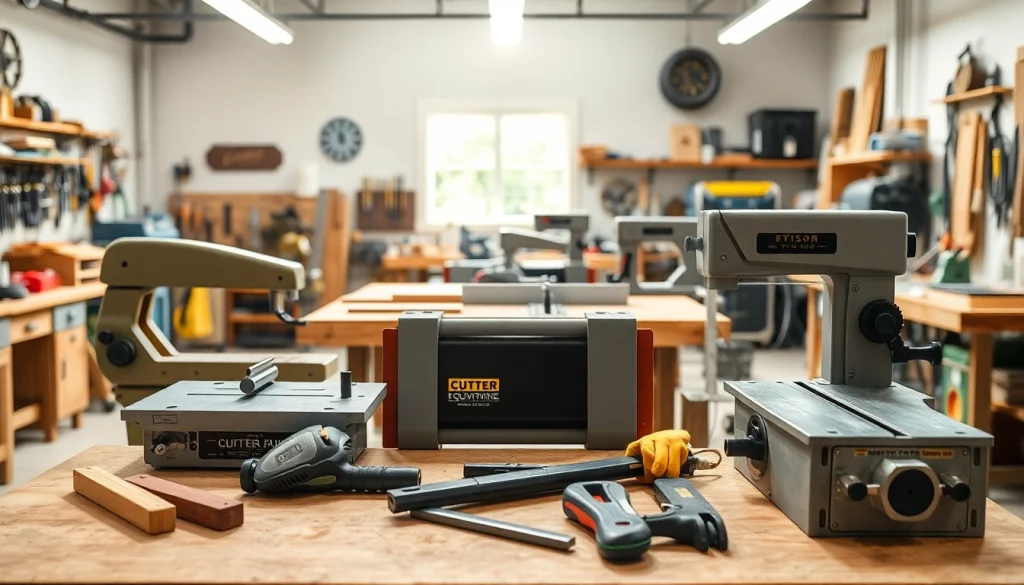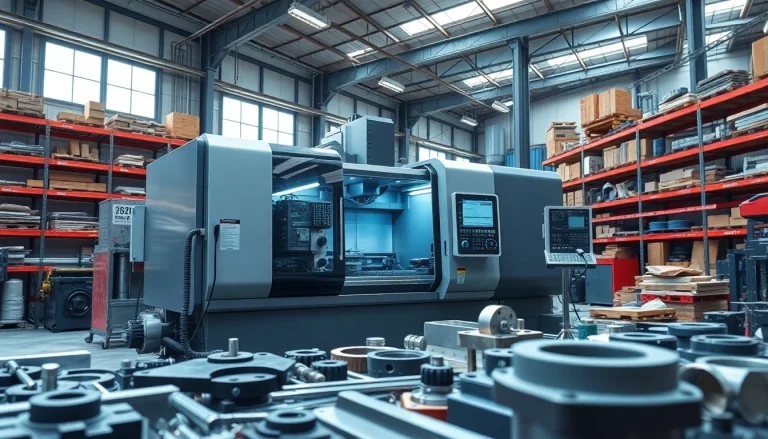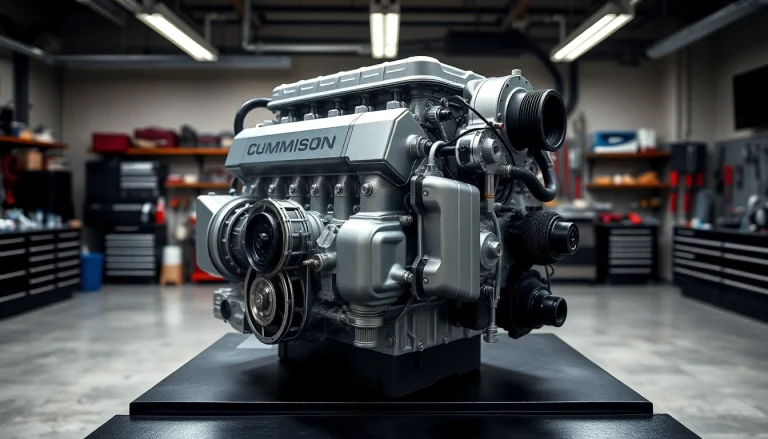
Understanding Cutting Equipment: An Overview
Cutting equipment plays a pivotal role in a multitude of industries and applications, ranging from construction to crafting. The term encompasses a broad variety of tools and machines designed for precise cutting, slicing, or shearing of materials. As the demand for accuracy and efficiency has surged in modern production and craftsmanship, the importance of selecting appropriate cutting equipment has never been more significant. For professionals and DIY enthusiasts alike, understanding the intricacies of cutting equipment is essential for achieving optimal results and safety.
Types of Cutting Equipment
Cutting equipment can be classified into several categories based on their application and design. Below are some common types:
- Hand Tools: These include knives, scissors, shears, and manual saws designed for smaller tasks and precision work.
- Power Tools: These encompass a range of electric or battery-operated tools like circular saws, jigsaws, and angle grinders, which can handle larger projects with ease.
- Industrial Cutting Machines: These include specialized machines designed for heavy-duty applications, such as plasma cutters, waterjet cutters, and CNC machines.
- Food Cutting Equipment: Tools like slicers, dicers, and professional-grade kitchen knives tailored for food preparation.
- Crafting Equipment: Tools like Cricut machines, laser cutters, and die-cutters that cater specifically to the crafting community.
History and Evolution of Cutting Tools
The history of cutting tools dates back to prehistoric times when early humans used rudimentary stones to cut through animal hides and vegetation. Over centuries, these tools evolved:
- Stone Age: Basic cutting tools made from flint and obsidian.
- Bronze Age: Introduction of metal tools, significantly improving durability and sharpness.
- Industrial Revolution: Makings of powered cutting machines, expanding cutting capabilities across industries.
- Modern Era: Innovation and automation with CNC technology changed the production landscape dramatically, allowing for increased precision and efficiency.
Key Features to Look For
When selecting cutting equipment, various key features should be taken into account to ensure that the tools meet the necessary performance and safety standards:
- Material and Durability: The quality of material used can impact the tool’s longevity and effectiveness.
- Precision and Accuracy: For tasks requiring exact cuts, look for tools that offer adjustable settings and guides.
- Safety Features: Features such as blade guards, safety triggers, and non-slip grips are paramount to protecting the user.
- Power and Performance: For powered tools, consider the motor strength and capabilities to handle various materials.
- Ease of Use: User-friendly designs can minimize the learning curve for new users.
Applications of Cutting Equipment in Different Industries
Construction: Use of Cutting Equipment
In the construction industry, cutting equipment is indispensable. Tools like saws, chisels, and concrete cutters are commonly utilized for tasks ranging from framing to surface finishing. For instance, concrete cutting tools, such as wall saws and core drills, allow for precision in creating openings for doors and windows in existing structures.
Moreover, the industry has progressed towards using advanced technology, leading to the incorporation of diamond blades and automated cutting systems, which enhance efficiency while significantly reducing the risk of human error.
Food Industry: Specialized Cutting Gear
The food industry employs a vast range of cutting equipment to prepare ingredients efficiently and safely. Equipment such as slicers, dicers, and commercial-grade knives are vital for food preparation in restaurants and food processing plants. For example, industrial food slicers provide consistent cuts, improving food presentation and cooking times.
Furthermore, innovative technologies like mandoline slicers and automated food cutting machines are transforming food processing, enabling quick, uniform cutting necessary for large-scale operations while maintaining food quality and safety standards.
Crafts and Hobbies: Tools for Precision Cutting
In the realm of crafts and hobbies, the right cutting equipment can make the difference between an amateur and a professional finish. Craft knives, rotary cutters, and laser cutters enable precision cuts in materials like paper, fabric, and wood. For instance, the Cricut machine has become a favorite among crafters for its versatility in cutting intricate designs and patterns effortlessly.
Micro-cutting machines and 3D printers are also becoming increasingly popular for hobbyists, giving them the ability to create detailed models and customized projects that were previously impossible without professional-grade tools.
How to Choose the Right Cutting Equipment
Assessing Your Needs: Professional vs DIY
Determining the purpose of your cutting equipment is crucial before making a purchase. Professionals in industries like carpentry or culinary arts may require industrial-grade tools designed for continuous heavy use, while DIY enthusiasts may only need handheld tools for occasional projects. It’s important to assess the frequency and type of use to select tools that meet your requirements.
Factors to Consider: Safety, Efficiency, and Cost
When choosing cutting equipment, prioritize safety features to minimize the risk of injury. Tools with safety guards, start triggers, and lightweight designs are ideal. Efficiency is also essential—invest in tools that enhance productivity without compromising quality. Cost should factor in, but it’s crucial to balance price with performance; sometimes, investing in higher-quality tools can save money in the long term through durability and effectiveness.
Top Brands in the Cutting Equipment Sector
Numerous reputable brands excel in providing cutting equipment across various categories:
- DeWalt: Known for durable power tools used in construction.
- Wüsthof: Specializes in high-quality kitchen knives valued by chefs worldwide.
- Brother: Offers versatile cutting machines primarily used in crafting.
- Makita: Renowned for its innovative cutting tools and equipment in construction.
- Husqvarna: A leader in concrete cutting and surface preparation equipment.
Maintenance Tips for Longevity of Cutting Equipment
Cleaning and Storage Best Practices
To ensure the longevity of your cutting equipment, proper cleaning and storage are paramount. Always follow the manufacturer’s guidelines for cleaning after use. For manual tools, wipe down blades with a damp cloth to remove debris, and store them in protective cases or sheaths to avoid accidental damage. For power tools, check dust collection ports regularly, and store them in a dry area to prevent rust.
Sharpening Techniques for Optimal Performance
Keeping blades sharp is vital for cutting efficiency. For manual tools, use whetstones or honing rods, following a consistent angle to maintain the blade’s profile. For industrial knives and blades, consider professional sharpening services to prolong the lifespan of tools while ensuring optimal performance.
Regular Inspections: Ensuring Safety
Conducting regular inspections of cutting equipment ensures safety and performance. Check for signs of wear on blades, loose components, and any damage to electrical wires. Performing these checks proactively can prevent accidents and costly repairs.
Emerging Trends and Innovations in Cutting Equipment
Smart Technology and Automation
As technology advances, cutting equipment is becoming increasingly intelligent. Innovations such as CNC (Computer Numerical Control) machines have transformed manufacturing processes by providing unparalleled precision and consistency. Furthermore, smart features such as sensor-based operations are being introduced, allowing machines to adjust settings automatically based on material types, leading to greater efficiency.
Sustainable Practices in Equipment Manufacturing
With growing environmental awareness, manufacturers are focusing on sustainable practices. This includes the use of recyclable materials in tool production and energy-efficient machines that minimize electricity consumption. Choosing equipment with eco-friendly certifications can positively impact the environment and offer businesses a competitive edge.
Future of Cutting Equipment in Various Industries
The future of cutting equipment looks promising, with ongoing innovations expected to enhance performance and safety. As industries evolve, the incorporation of AI and IoT (Internet of Things) technologies is poised to optimize cutting processes, allowing for better inventory management and predictive maintenance. The adaptation to changing market needs and technology will continue to define the landscape of cutting equipment across all sectors.





